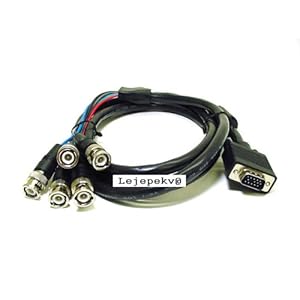Used to be the higher end equipment would use BNC connectors it's supposed to have a better image here is some more info.
Oh and here is the cable also
http://www.amazon.com/gp/product/B001L2DGA2/ref=pd_lpo_k2_dp_sr_2?pf_rd_p=486539851&pf_rd_s=lpo-top-stripe-1&pf_rd_t=201&pf_rd_i=B002ZDJSRQ&pf_rd_m=ATVPDKIKX0DER&pf_rd_r=1RS5NBZBR5R0VTA5RH52 http://repairfaq.ece.drexel.edu/sam/monfaq.htm#monsuvbcabShould I use a VGA to BNC cable if my monitor has BNC connectors?
http://repairfaq.ece.drexel.edu/sam/monfaq.htm#monsuvbcabShould I use a VGA to BNC cable if my monitor has BNC connectors?(The following assumes a normal video card with a mini-DB15 VGA/SVGA connector - if yours has BNC connectors, the improvement may be even greater.)
The answer is an unqualified maybe. In principle, the BNC cable should have higher bandwidth and better transmission line characteristics (impedance, termination) and result in sharper crisper images with less ghosting, ringing, and other artifacts. However, this will only likely be significant at higher refresh rates (1024x768 at 75 Hz and beyond) and depending on your monitor and video card, you may see no change - or it may even get worse. It is best to purchase a good quality VGA to 5-BNC cable with a return privilage and try it. I suggest a 5-BNC cable even if you only need 3 or 4 connectors so that it will be compatible with any monitor or video card you might have in the future. Cost should be in the $25 to $70 range.
Potential advantages of using the BNC connector inputs on your monitor with a good quality cable are:
higher video bandwidth -> sharper display.
proper connectors (at one end, at least) and correct termination implies less ghosting and ringing.
For a good monitor with a high quality video card, the difference can be dramatic - as is the case with my ATI GPT and NEC 5FG.




 Home
Home Help
Help Search
Search Login
Login Register
Register
 Send this topic
Send this topic Print
Print



